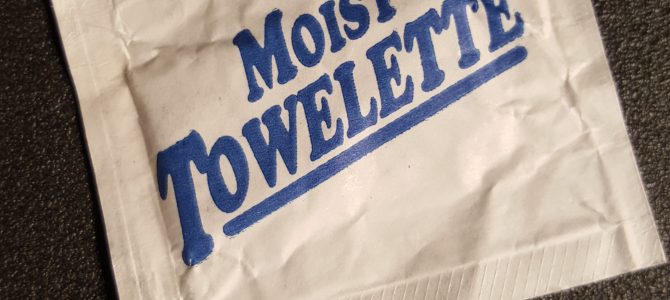In the front office, break room, shop floor, and the back of the glove compartment in your car, you’re sure to find those neat individual packets of alcohol wipes. Small towelettes soaked in alcohol – usually isopropanol or ethanol – they’re handy to have around for small clean-ups. But how are they transported? The purpose of this article is to provide guidance in the classification of alcohol wipes for the purposes of transportation and to identify and explain an exception to the Hazardous Material Regulations (HMR) of the USDOT/PHMSA.
First of all, some necessary conditions regarding the alcohol wipes I am about to classify:
- Towelettes are saturated with a Class 3 Flammable Liquid of packing group II or III.
- Amount of Class 3 Flammable Liquid in each sealed packet is less than 10 mL.
- No free liquid in the sealed packet.
It will look and be used like this:
The mistake made by many is to classify the alcohol wipes for transportation as if they are the pure form of the alcohol they contain, examples below:
- UN1219, Isopropanol or Isopropyl alcohol, 3, II
- UN1170, Ethanol or Ethyl alcohol or Ethanol solutions or Ethyl alcohol solutions, 3, II or III
Classified as one of the above, a person offering these for transportation would either have to ship them as a fully-regulated HazMat or find a packaging exception, e.g. limited quantity, that eliminates some – but not all – of the requirements of the HMR. In fact, it is not uncommon to find this classification in section 14 of the Safety Data Sheet (SDS) for an alcohol wipe. Like this:
But that is the incorrect way to classify an alcohol wipe. Instead, the classification should be determined by the finished article you intend to ship, i.e. a solid (the towelette or wipe) saturated with a Class 3 Flammable Liquid. With that identification a better classification from the Hazardous Materials Table at 49 CFR 172.101 is available: UN3175, Solids containing flammable liquid, n.o.s., 4.1, II, (contains isopropanol).
“What’s the difference?” you ask? “It’s still a hazardous material. Still subject to the HMR. Why should I classify it as UN3175 instead of UN1219 or UN1170?” The answer is found in the special provisions of column 7 of the Hazardous Materials Table. Specifically, special provision 47 which is applicable to solely to UN3175. The meaning of special provision code 47 in column 7 is explained at 49 CFR 172.102. You’ll have to skim through the first two sentences which refers to mixtures of non-HazMat solids with flammable liquids until you arrive at the critical third sentence, which reads:
Small inner packagings consisting of sealed packets and articles containing less than 10 mL of a Class 3 liquid in Packing Group II or III absorbed onto a solid material are not subject to this subchapter provided there is no free liquid in the packet or article.
The language from the above: “…are not subject to this subchapter…” means it is not subject to the Hazardous Material Regulations of USDOT/PHMSA and therefore is not a hazardous material in transportation. Please refer to this USDOT/PHMSA letter of interpretation for confirmation: 01-0289.
|
Contact me with any questions you may have about the transportation of hazardous materials by air, highway, vessel, or rail International and Domestic Daniels Training Services 815.821.1550 |
And there you have it! Classify an alcohol wipe as if it is a pure substance and you’ll likely result with a hazardous material. Classify it for what it is and you’ll be able to take advantage of Special Provision 47.
The above only deals with its classification for the purposes of transportation. What do you do once you’ve used the alcohol wipe and now must discard it? That is when the regulations of the Environmental Protection Agency (EPA), and those of your state if it has an authorized hazardous waste program, will apply. As the generator of a waste you must conduct a hazardous waste determination. If the result of the hazardous waste determination is your discarded alcohol wipe is a hazardous waste then you may wish to take advantage of the Solvent Wipe Exclusion.
|
Contact me with any questions you may have about the generation, identification, management, and disposal of hazardous waste Daniels Training Services 815.821.1550 |

